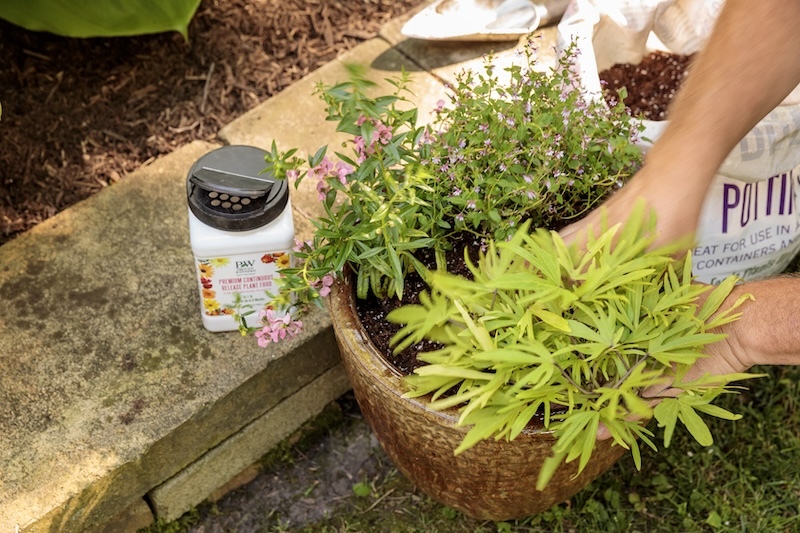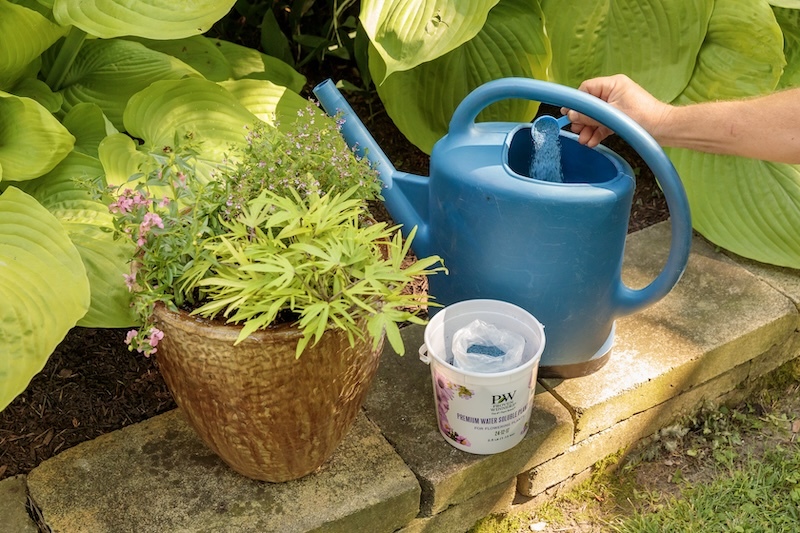Plants growing in a container require regular fertilizing to replenish nutrients lost over time. The plant uses up nutrients in the potting soil, and watering leaches nutrients out of the soil. If the nutrients are not replaced, the plants may struggle to grow and bloom well. Read on to learn how and when to fertilize containers, so you can grow luscious, healthy plants.

How to Apply Fertilizer to Potted Plants
Annuals and most perennials respond well to quick-acting liquid fertilizer diluted in water. Regular applications spaced every 2-3 weeks will keep nutrients levels even and support steady growth. Potted shrubs and trees appreciate a top dressing of a granular, slow-release fertilizer up to 3 times a year.
No matter what type of fertilizer you use, do not apply it to dry soil or plants that are stressed by heat or lack of watering. Always follow the manufacturer's instructions for dosage and resist the urge to over-feed. Too much fertilizer will weaken plants and may burn the roots.
How Often to Fertilize Potted Plants
How often you feed depends on the fertilizer you use and the plants you are growing. Here are some general rules: Annuals, edible plants and perennials will need regular fertilizing with a diluted liquid feed every 2-3 weeks depending on watering frequency. Shrubs and trees in containers can be fed once or twice a growing season. Use a slow-release fertilizer for plants that are permanently potted. Sprinkle it on the soil at the beginning of the growing season and again 2-3 months later.

When to Fertilize Potted Plants
Fertilizing should only be done when plants are actively growing and taking in nutrients from the soil. Plants are essentially inactive when the weather is very cold, below 50 degrees F, and very hot, above 95 F. The root system slows its growth to prepare for dormancy and to protect the top growth from adverse weather conditions. Fertilizer applied during extreme temperature conditions will wash out of the soil, wasting your effort and potentially contaminating local water sources.
Best Fertilizer For Potted Plants
Ornamental shrubs, trees, and grasses with showy foliage will benefit from a fertilizer with a balanced NPK ratio (e.g., 1-1-1). A balanced ratio will support foliage growth (N), rooting, and blooming (P and K). Blooming plants like most annuals and perennials perform best with an NPK ratio around 1-4-3. Look for products marketed specifically for blooming and rooting. Tomato and rose fertilizers also work well for blooming plants and should be applied at the same rate as recommended for tomatoes.
Fertilizing Tips
- Pelletized, slow-release fertilizer is a good solution for people who don't have the time or or desire to apply regularly scheduled feedings
- Always follow the manufacturer's dosing instructions. Fertilizers can vary widely depending on the brand
- Over-feeding can be as bad for plants as under-feeding
 |
Author Robbin Small - Published 4-13-2024 |
